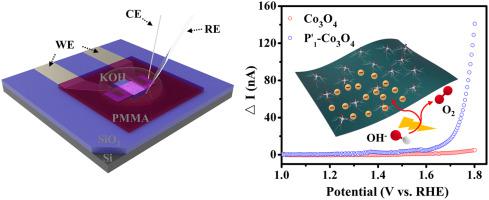Nano Energy ( IF 16.8 ) Pub Date : 2021-01-07 , DOI: 10.1016/j.nanoen.2021.105748 Xunbiao Zhou , Xiaobin Liao , Xuelei Pan , Mengyu Yan , Liang He , Peijie Wu , Yan Zhao , Wen Luo , Liqiang Mai

|
Transition metal phosphides or partially phosphatized oxides usually suffer from surface reconstruction during oxygen evolution reaction (OER), but still possess enhanced catalytic activity than directly synthesized oxides, which has aroused great interest in exploring the causes of such high catalytic activity. To monitor electronic property of catalyst during the OER can provide crucial insights into catalytic ability. Here we design a planar electrochemical microdevice based on individual thin-film catalyst, and for the first time explore the continuous electric conductance evolution of lattice P-doped oxides during the electrochemical activation process. Moreover, combining on-chip electrochemical impedance spectra measurements, in situ I-V measurements, and theoretical simulations of reconstructed lattice P-doped oxides, the effect of P–O groups on new-formed oxides is clarified. The induced electronic coupling between new-formed oxides and P-O groups has been studied and demonstrated. The coupled P–O groups effectively promote the metal–oxygen covalency of new-formed oxides, which accelerates electron transfer between active metallic center and oxygen adsorbates, thus leading to the enhanced electrocatalytic activity. Our study highlights the role of surface P–O groups in Co3O4 during the OER, and such unique on-chip electrochemical microdevice platform can also be applied in other related fields to understand the dynamic behavior of energy materials at nanoscale.
中文翻译:

通过片上微型器件揭示了表面P–O基团在P掺杂的Co 3 O 4中对电催化氧释放的作用
过渡金属磷化物或部分磷化的氧化物通常在氧释放反应(OER)过程中遭受表面重构的影响,但与直接合成的氧化物相比,仍具有增强的催化活性,这引起了人们对探索这种高催化活性的原因的极大兴趣。在OER期间监测催化剂的电子性能可以提供对催化能力的重要见解。在这里,我们设计了基于单个薄膜催化剂的平面电化学微型器件,并首次探索了在晶格P掺杂的氧化物在电化学活化过程中的连续电导演化。此外,结合原位IV的片上电化学阻抗谱测量测量和重构的晶格掺杂P的氧化物的理论模拟,阐明了P–O基团对新形成的氧化物的影响。已经研究和证明了新型氧化物和PO基之间的感应电子耦合。偶合的P-O基团有效地促进了新型氧化物的金属-氧共价,从而加速了活性金属中心与氧吸附物之间的电子转移,从而增强了电催化活性。我们的研究强调了OER过程中表面P–O基团在Co 3 O 4中的作用,这种独特的片上电化学微器件平台也可以应用于其他相关领域,以了解纳米级能量材料的动态行为。











































 京公网安备 11010802027423号
京公网安备 11010802027423号